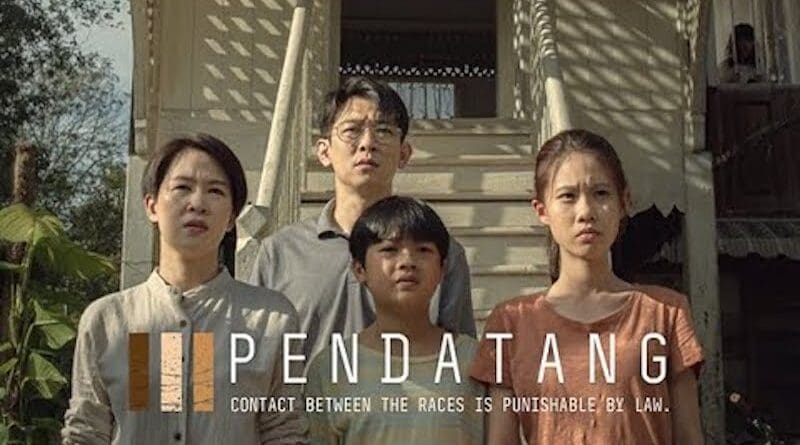Malaysia: A Review Of Pendatang – OpEd
Was it fantasy or a window into a near reality?
On the night of December 21, a film created by Kuman Pictures “Pendatang”, which literally means immigrant in Malay, had its world livestreaming premiere on YouTube. This dystopian film was set in a Malaysia, after both Sabah and Sarawak had left the Federation.
In this parallel reality, Malaysia had now become a segregated nation, where the various races lived within respective controlled areas. Different races were forbidden to mix with each other. In the story, the Wong family were ordered to relocate to an old wooden kampong house, previously occupied by Malays in a remote rural area, after committing a traffic offence.
After living in the house for a few days, members of the Wong family discovered a Malay girl who had been hiding in the house. After the father wanted to turn her in to the authorities, which would have most probably led to her death, the family decided to help send the Malay girl to her own people.
What was unique about this film is that it was produced on a very low budget of RM 300,000, raised solely through crowd funding. The general release of Pendatang on YouTube meant the film would not generate any revenue. This was an altruistic act by 600 crowd funders of the movie, who wanted it freely available to everyone.
Releasing the film on YouTube had a great advantage in that it would not have to go through the Film Censorship Board (LPF). This enabled Pendatang to touch on issues it wouldn’t have been able to do, if it was made and released in the traditional manner.
The movie launch was very much a risky experiment and attracted 20,000 viewers in the first 2 hours of livestreaming. After 12 hours on YouTube the movie has attracted over 80,000 views, more than 3,000 likes and 500 comments.
This is director Ng Ken Kin’s seventh film, very much under a Hong Kong film influence, working off the screenplay by Boon Siang Lim. The cinematography by Tan Teck Zee showed what a new generation of Malaysian filmmakers are capable of. The cast was relatively new to the screen, but showed what can be done in serious drama acting.
The prime language used in the film was Cantonese. The use of Cantonese allowed the use of expressions and emotions, other dialects might not have shown so clearly. The use of language was much freer than it would have been going through the Film Censorship Board. The realism of the dialogue therefore matched the cinematography.
Pendatang simply provides a view of what the nation could look like in the future. In this way, Pendatang is not unsimilar to films like 28 Days Later (2002), Fahrenheit 451, and Orwell’s 1984.
The main theme of the film was how racial segregation is used to suppress people and how it leads to corruption by those who use racism to obtain their power from such divisions. Additionally, Pendatang shows how totalitarianism leads to Apartheid and creates a culture of fear and nurtures abuse.
Feeding off such an environment, cronyism develops, where the authorities are used as gangsters, and corruption becomes rife. This is metaphoric of Malaysian society and the divisions we see today.
Yet, paradoxically at a person-to-person level, Pendatang shows that even though a nation is politically divided, there is a bonding between people of the different communities in Malaysia. From this perspective the Malay girl hiding in the house, depicts hope.
At a completely different level, Pendatang shows what Malaysians have lost. The simple kampong life, where upon the Wongs arrival at the wooden kampong house, they had to rehabilitate it, and adapt to the way of life the house requires.
Pedatang gave us many insights into power. Even though each race was segregated, a powerful elite rose within each of the racial groups to brutally control and suppress their own.
In this way, Pendatang can be seen as an anti-authoritarian through the film’s depiction of roadblocks, police brutality, and unchecked gangsterism and lawlessness of the authorities themselves.
Most importantly of all, Pendatang gave the viewers a glimpse of the anguish and heartache people go through living in such societies. Sectional beliefs and narratives only add fear about others, which turns out to be unfounded.
Pendatang sends a clear message about what is happening in Malaysia today. Pendatang shows the ugly, with the loudspeakers in the background symbolising authority and oppression. However, at the end, Pendatang shows people need to trust others and bond as human beings. This is what makes up the true fabric of society.
Although some saw the early parts of the film slow, while the scene was being set, many others saw the film as a window to reflect upon life today.
That’s the power of Pendatang. One has to see if the authorities in Malaysia today react to the film. Pendatang should be in the running for film awards over the next year, which should be a major encouragement for the brave new paradigm Pendatang took in filmmaking.

